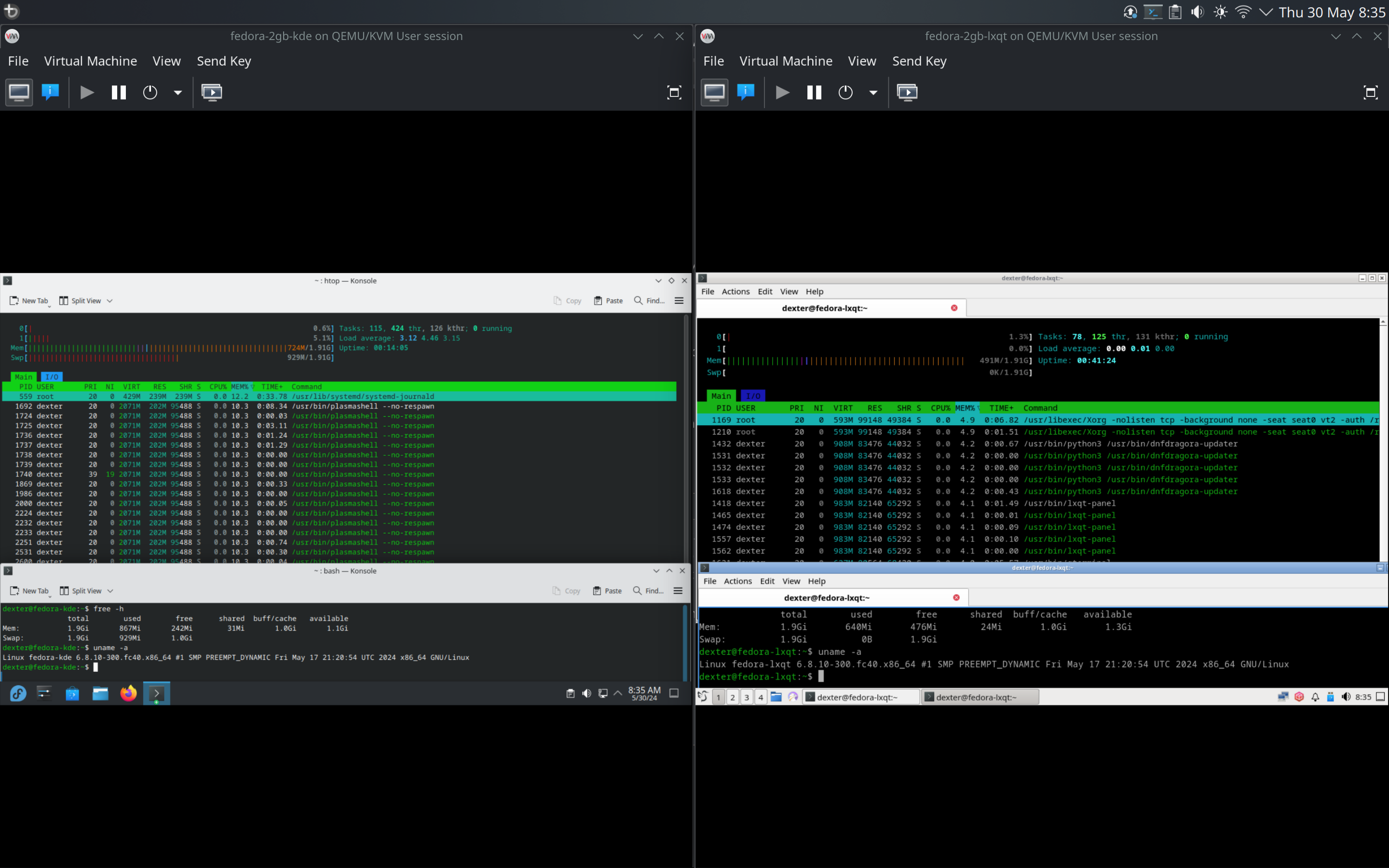Suppose you’ve got an old PC - for arguments sake, assume a late 2000s PC with only 2GB RAM - which DE would you choose?
Note that whilst a simple WM + some lightweight apps might be a better option, to keep things simple, I’m limiting this poll to just DEs - and too ones which are still being maintained.
Also, in case you’ve voted for a non-obvious/“other” option, I’m curious to hear about your experiences on running that DE on an old machine - and why you’ve selected it over the more obvious choices.
Antix linux does great “de” with icewm
Ditto. Running antix on my netbook and I think icewm had the lowest resource usage of the defaults.
Just install a few of them, see what works, how much resources they use up, and what allows you to open more than one browser tab. Hell do it in a VM, Arco-B has a wide range of DE’s to choose from in the installer.
I have a laptop of that era (2008 HP Pavilion, Athlon64x2, 2GB RAM, 100GB HDD). It runs the Trinity Desktop Environment, which works just as well now as it did when that laptop was a flagship machine. (Updating a Gentoo system running on a machine that old is a bit time-consuming, mind you, but that isn’t the DE’s fault.)
I’ve tried several of the other lighter-weight DEs—XFCE, LXDE, Lumina, Gnome2 before it became MATE—but TDE does what I need it to do, and (just as importantly) the development team prefers to work on features and compatibility rather than tearing out things that still work or forcing new paradigms that don’t really make sense for my use case onto me. It’s there, it’s solid, and I’ve already learned its quirks, so I can save my brain cells for learning useful features in other programs rather than having to figure out where the control for some bit of the GUI ran off to this time. Why would I use anything else? The thing I want most from my DE is for it to stay out of the way and not keep me from using other software.
(Plus, Konqueror may no longer be useful as a web browser, but it’s still a better file manager than, say, Thunar, which I found to be a pain in the arse when I tried XFCE.)
Just because a DE looks sparse doesn’t means it also uses less resources. In imagine KDE would actually run well as it doesn’t need all the bells it offers and is actually a well written performant DE.
It does not run well. You can’t see the performance difference between KDE and XFCE on neofetch, but you absolutely can on on old machine.
Source: I have an old computer.
imagine KDE would actually run well as it doesn’t need all the bells it offers and is actually a well written performant DE.
RAM usages on a 8GB system, 4 hours after boot.
- plasmashell: 312 MB
- kwin_wayland: 165 MB
- akonadi_* summed: ~2 GB
- kded5: 130 MB
- kalendarac: 119 MB
- xdg-desktop-portal-kde: 107 MB
- kwallet5: 103 MB (unused)
- kaccess: 103 MB
- kiod5: 103 MB
- polkit-kde-auth: 101 MB
- X, Xwayland combined: 202 MB
- org_kde_powerdevil: 48,5 MB
- kactivitymanagerd: 40 MB
- startplasma-wayland: 39 MB
There’s also various other things too. Now obviously, looking at the total used counter, these cannot be just summed up, there must be some overlap through shared libraries and such, because if I close my web browser and all I have open is Konsole, total memory usage drops to 2,35GB. 3rd party programs, like opensnitch and syncthing, only contribute 400 MB (opensnitch is surprisingly fat, but it’s UI is not efficient with the CPU either), so the system itself needs around 1,9 GB, but that’s a lot when all you have is 2 GB RAM.
Then, my system uses an additional 2 GB for cache purposes. Such an old system will probably have an older, much slower storage (unless upgraded, fortunately that’s often easy), and won’t have nearly any capacity to keep a filesystem cache.I’m only using a single widget on the desktop to periodically run a command and display it’s results. Other than that, the taskbar panel has the default widgets.
deleted by creator
I tested this myself on two identical VMs with 2GB RAM, one installed with Fedora 40 KDE, and another with Fedora 40 LXQt, both set to use X11 (because LXQt isn’t Wayland ready yet), both updated and running the latest kernel 6.8.10-300.fc40.
I logged into the DEs, opened only two terminal windows and nothing else, ran, and ran htop:

The KDE VM was unsable when I disabled swap - it completely froze on me. Meanwhile, LXQt chugged on just fine. Of
Of course, I could get rid of some bloat like akonadi, so I did that and rebooted my machine. Then I compared just the essential components, but I excluded plasmashell because it includes stuff like the panel and notifications, unlike LXQt where they’re all separate components so you can’t really compare them:
Component Process_KDE RAM_KDE Process_LXQt RAM_LXQt WM kwin_x11 99 openbox 18 Terminal konsole 76 qterminal 75 File Manager Dolphin 135 pcmanfm-qt 80 File Archiver ark 122 Lxqt-archiver 73 Text Editor kwrite 121 featherpad 73 Image Viewer gwenview 129 lximage-qt 76 Document Viewer okular 128 qpdfview-qt6 51 Total 810 446 plasmashell was sitting at 250MB btw in this instance btw.
I’d try AntiX with iceWM, but you could try MX with Xfce too. I guess your old PC is 32bits, both distro support it. I installed XM 32 bits on a old atom 32 bits, it works fine
Running mxlinux on an old pc here, and I recommend it heavily. It’s a lightweight system that is also user friendly for people new to linux.
MX is just fine, I wouldn’t ever hesitate to use it. I’ve loved SuSe since the chameleon sold me back in the 90’s, but MX is my fallback/goto distro now.
deleted by creator
i3 isn’t a proper DE, though, but I definitely would go with that with that little RAM.
For strictly DEs, I’d pick XFCE - it’s just lovely for what it demands.
Same. i3wm first, or XFCE for a “real” DE.
I am currently running a debloated i3wm rig based on EndeavourOS/Arch and I really enjoy the low mental load of a truly minimal desktop. Only luxury I’ve allowed myself is CLI colors. I’m not ready for B&W yet.
On a machine with 2 GB of RAM, what is going to make the biggest difference is using a 32 bit distro. Everything, not just the desktop environment but also all the apps, is going to take about half as much RAM. At 2 GB, that takes your system from functionally useless to quite useful ( especially if you plan to open a web browser ).
There is an option you did not list that impressed me recently. Trinity is a desktop environment that is essentially modern KDE 3.
The 32!bit edition of Q4OS makes it easy to install Trinity. It is basically Debian under the hood so you get access to all those packages ( at least the ones available on 32 but ).
32 bit distros also create the problem of being unable to access more than 3.2 GB RAM, as opposed to 4 GB RAM.
deleted by creator
It looks like if you enter an “Other” option, it adds it to the list for others to select. Some troll must have added the others you can see on the results page they are marked as “(Other)”.
Surprised how many others are gravitated toward iceWM as I am… though I daily drive MATE
Seems perfect for a functional desktop with minimal idle CPU usage. It had come to my mind again as a perfect pair for the open source e-ink display.
My PC with 4GB of RAM and an HDD is barely holding with linux mint. Tbf Mint isn’t the problem, it only takes 32% of ram compared to the 60+% of a debloated windows 10. It’s the other apps. Running a browser along anything else and Linux mint starts to struggle, even the built-in apps like the file manager and the text editor feel like they’re gonna crash the computer at any moment because of the random freezing/ delays.
My advice would be to try upgrading to 4GB and installing an SSD. Your old computer will likely only support SATA SSDs, which have a max speed of 500MB/s, but it’s far better than the 30MB/s at best that the HDD disks give.
There us no reason in 2024 to use a HDD as the boot drive.
Unless it’s all you have. Speaking as someone that’s at times been poor af, sometimes people just have to cobble up a frankensystem from whatever parts they can scrounge.
One of the things I love about linux is that it makes this reasonably possible.
You realize you could get a SSD for cheaper
xfce is fine, generally for most things.
From my experience it’s barely lighter than KDE. LXQT/LXDE destroy it in every benchmark and in every test I’ve tried.
It’s about 300mb lighter than KDE in my experiences. On 2gb of RAM, that makes a difference. Sure, going LXDE is gonna be fine too; but it lacks a lot of the polish that XFCE has. I honestly like both for different things.
It’s about 300mb lighter than KDE in my experiences. On 2gb of RAM, that makes a difference.
And both LXDE and LXQT use half as much RAM as Xfce.
LXDE is gonna be fine too; but it lacks a lot of the polish that XFCE has. I honestly like both for different things.
I’d rather be able to open more than 5 tabs than have a fancy UI. That’s why Xfce is on my newer devices, and I install those 2 whenever someone needs an ancient laptop revived.
It depends on what you are doing. KDE is not as clean and light weight
The point is that LXQT and LXDE use half as much ram as Xfce. I’m not saying OP should use KDE.
From my experience, while LXQt uses ~20-25% less RAM than XFCE, it runs way faster and uses less CPU than XFCE.
@d3Xt3r@lemmy.nz, did you actually look at the options in this poll? Because some of them are as racist and as fascist as can be imagined.
Lmao good ol gnome used to work great, which is why i recommend xfce :P
Also, search craigslist. People here at least, always have old RAM for free or cheap. Or even check AliExpress, I picked up 4 gigs of samsung RAM for $18 through Ali










